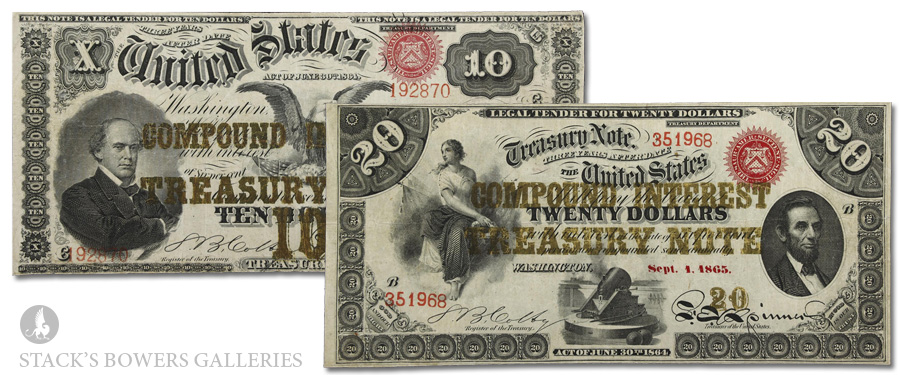
Recent scholarship from Nicholas J. Bruyer has helped shed light onto an often-overlooked field of numismatics from a tumultuous period in American history. In his book U.S. Treasury Notes 1812 – 1865: An Illustrated History Bruyer goes into significant detail about the histories of Treasury Notes and the Interest Bearing and the Compound Interest Treasury Notes issued during the American Civil War. Auction appearances of these notes are few and far between with those that survive often displaying impairments which often precede a “Net” or “Apparent” designation.
In our August 2024 Global Showcase Auction collectors will have the opportunity to bid on a pair of Compound Interest Treasury Notes from the Porter Collection representing the $10 and $20 denominations. First issued in June 1864, these notes were largely produced to fulfill Army payrolls; they accrued compound interest twice per year at 6% with a $10 earning $11.94 over a period of three years when the note reached maturity. They soon became subject to hoarding and speculation, with brokers offering sizable premiums. Notes bearing dates of October 1864 or earlier commanded the most consistent premiums. Compound Interest Treasury Notes became scarce in commerce and were shortly thereafter consigned to numismatic history.
The examples in our August auction are solid specimens offering boldly applied “COMPOUND INTEREST TREASURY NOTE” overprints in huge brownish-gold block letters (invented by Spencer Clark and readily used on fractional currency to prevent counterfeiting). The choice of subjects calls to mind the wartime context in which these were issued. The notes, found in lots 21113 and 21114, both display even circulation and strong eye appeal that is not often seen on many contemporary pieces.
For more information about our auctions or to consign your numismatic items, please call 800-458-4646 or email Info@StacksBowers.com.





